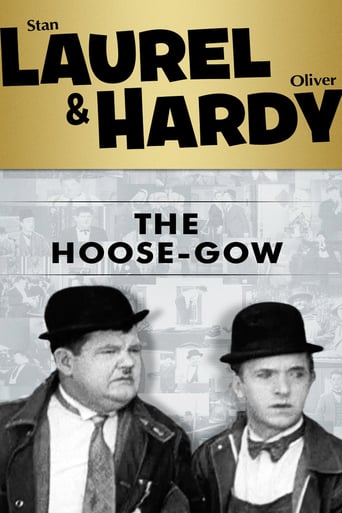mark.waltz
Laurel and Hardy are already in enough trouble, having been falsely arrested and sent to prison where they should be released just so they don't accidentally burn the prison down. They end up on a chain gang, try to chop a tree down that has a prison guard attached to it, and overfilling the governor's car up with gasoline with amusing results. This was two years before they starred in their first feature, "Pardon Us", a more detailed prison comedy. While photographed by George Stevens, this has some creaky moments of little sound, but that wet goo fight at the end is straight out of the keystone cops. A disturbing visual has Laurel's mouth stuffed with a whole apple which he can't get out and had me cringing.
Steve Pulaski
James Parrot's short film The Hoose-Gow opens with Laurel and Hardy being trafficked to prison after being mistaken for involvement in a hold-up. The two spend their days digging ditches, cutting down trees, and doing the hard manual labor in prison with the comedic longevity expected from two of the greatest masterminds in silent/talkie comedy. The two manage to get themselves into enough physical pain and trouble that makes up for their false prison sentence, but the two push on and try to pay their dues, even if it results in grave injury.This is one of the first times I've seen where slapstick really works for Laurel and Hardy. The Hoose-Gow doesn't make much of an effort to incorporate a lot of verbal wit, and instead, emphasizes the physical elements. For some reason, perhaps the result of a mood-change or an unconscious desire, I was pleased by the slapstick here, especially during the scenes when Hardy is attempting to cut down a tree and Laurel keeps getting in the way, nearly missing the sharp blade of the pickaxe. Scenes like that provide for slapstick that almost seems improvisational rather than a copout for screen writing.One can tell, however, this is an early sound-short because of the lack of formal dialog. The Hoose-Gow could've really been a silent short and simply had the timely luxury of being able to be produced with sound. My only assumption to the lack of real conversation was writers at the time, in this case, H.M. Walker, who wrote most of Laurel and Hardy's short films, was just getting used to screen writing with audible dialog, making the early sound-shorts lack the kind of leisurely- paced dialog that would be present in Laurel and Hardy's later shorts. It's not a particular flaw, just a difficultly in adapting on part of the short's crew, but it would've made for a more witty short.Yet The Hoose-Gow accomplishes a feat I never really thought possible with Laurel and Hardy shorts, which is make them more slapstick driven than dialog driven and have them turn out successful. For that, the film deserves a huge plus, and the fact that this is the most active I've seen both men in any project only adheres to their credibility has fantastic physical performers.Starring: Stan Laurel and Oliver Hardy. Directed by: James Parrot.
MartinHafer
This is an okay Laurel and Hardy film--about average overall. While the plot is a bit different than most of their films, the team did do several films where they were convicts (such as LIBERTY and PARDON US). And, of these films, this is perhaps my least favorite. It isn't because the film is really bad, but a lot of the humor isn't all that memorable and the rice throwing at the end seems very derivative--throwing pies, etc. is almost a cliché since it's been seen a lot already in older comedies. I just don't see why throwing food is funny--it just seems like a cheap laugh. If you are a die-hard fan, then this IS a film for you. For others who are not familiar with the duo, find another film first--this film isn't magical or a must-see film.
rsyung
An early Laurel & Hardy talkie, `The Hoose-Gow' is strongest in its first half…the pathetic attempts at escape, the sheer terror on Stan's face as he tries to dislodge the apple from his mouth, the absolute fear and despondency of two child-souls set down amongst a hardened prison population. Also priceless: Ollie's guileless explanation to guard Tiny Sanford: "Honest, officer, we were only watching the raid." Somehow, coming from Stan and Ollie, the statement rings of truth. In the work camp, things settle into the traditional Stan and Ollie mealtime gags. When they chop down the lookout's post it's another of those gags of anticipation which was such an integral part of their humor. And it's to their credit that most of the film is shot on location, something uncommonly problematic for the early sound technology of the late 20s. There is also something wistfully nostalgic about those Arcadian, windswept eucalyptus-lined locations of southern California, so unpopulated in 1929. Once they get involved in the creamed rice fight at the end, it descends into rather standard fare.


